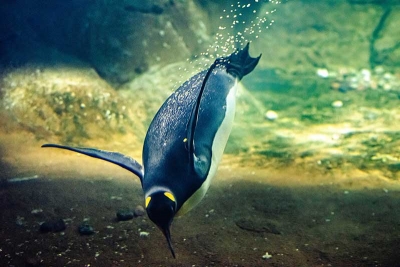
On land the flightless penguin is a clumsy, funny creature. Underwater it ‘flies’ with great speed and grace.
Penguins are birds of the ocean, spending up to 75 percent of their lives in the water. Some penguins, like the fiordland and rockhopper, have even been found with barnacles growing on their feathers! Much of what seems odd about penguins is due to the fact that they spend so much time in the water.
Swimming is what penguins do best. A penguin’s awkward waddle may seem comical on land but that’s because they are made to swim. Adaptive wizards of the sea, their torpedo shaped bodies combined with powerful flippers enable penguins to swim to considerable depths and over great distances. Their legs and feet, located far back on the body, contribute to the waddle on land, but underwater they act as streamlined rudders that minimize drag.
At the water’s surface a penguin can at best paddle like a duck, but below the waves penguins cruise at speeds faster than Olympic swimmers. The fastest, the emperor penguin, can reach 9 mph (14 km/hr) when in a hurry but prefers a steady 7 mph. Most midsize penguins swim around 5 mph (8 km/hr) and the smallest penguin, the little penguin, meanders at a slow 1 mph (1.5 km/hr). A traveling penguin keeps the surface within 3 to 6.5 feet (1-2 meters) often employing a swimming technique called porpoising. Porpoising is a shallow skimming across the water through a series of consecutive leaps, named for its similarity to how porpoises swim. The primary function of porpoising is its efficiency in moving quickly through the water while allowing for breathing at the surface without slowing down. It may also serve as a defense mechanism against predators—it makes it difficult to grab a swimming penguin when they are continually disappearing above the surface.
Credit : Smithsonian
Picture Credit : Google




